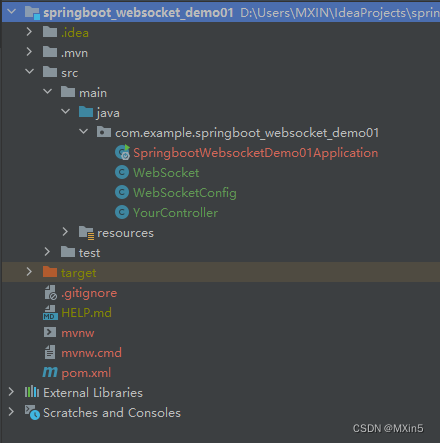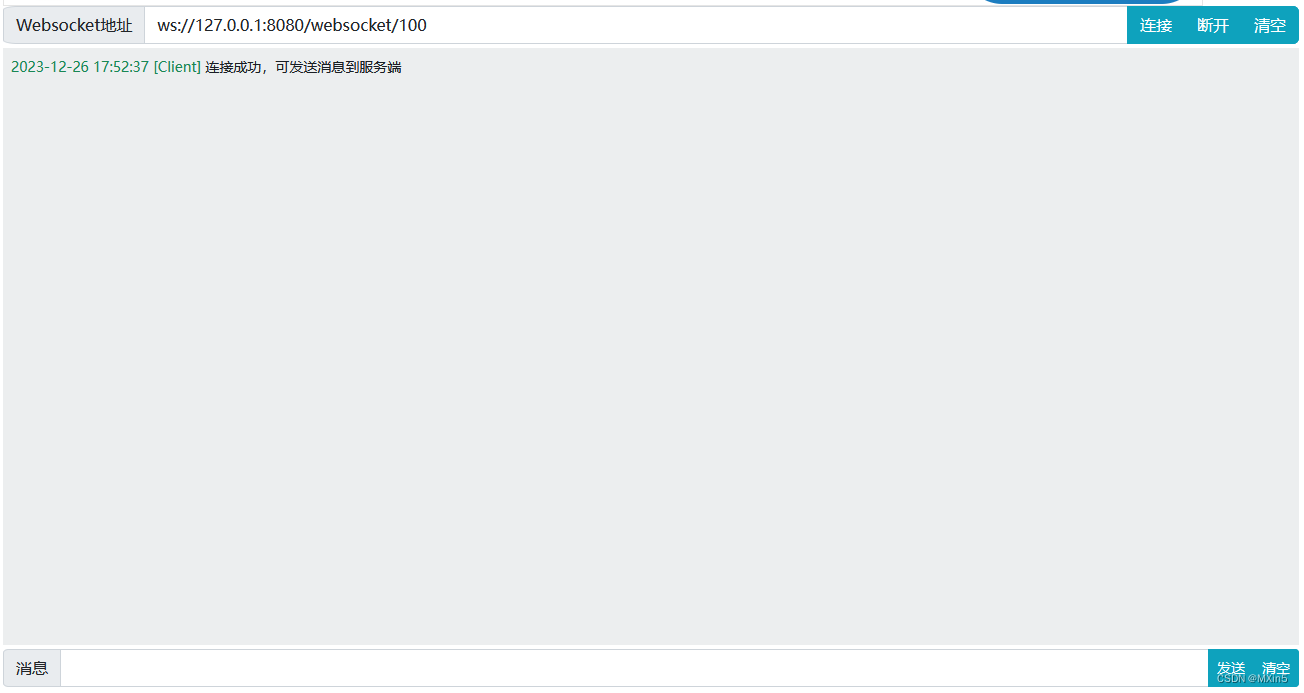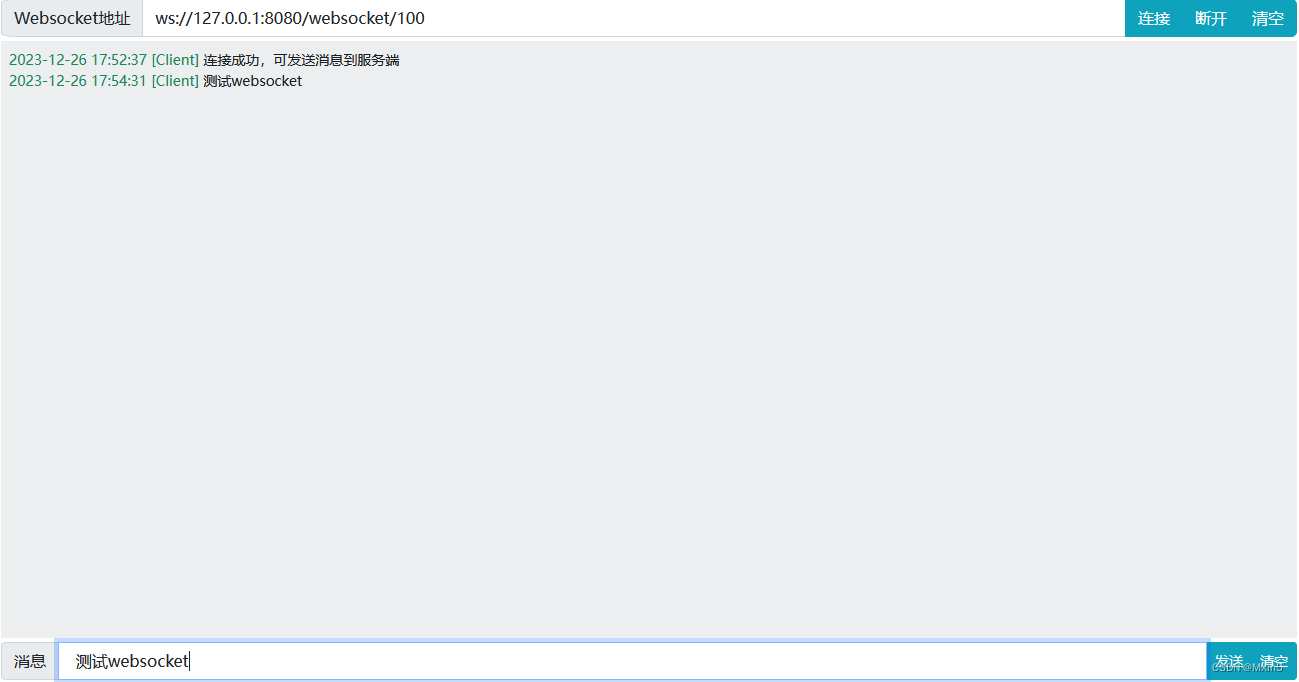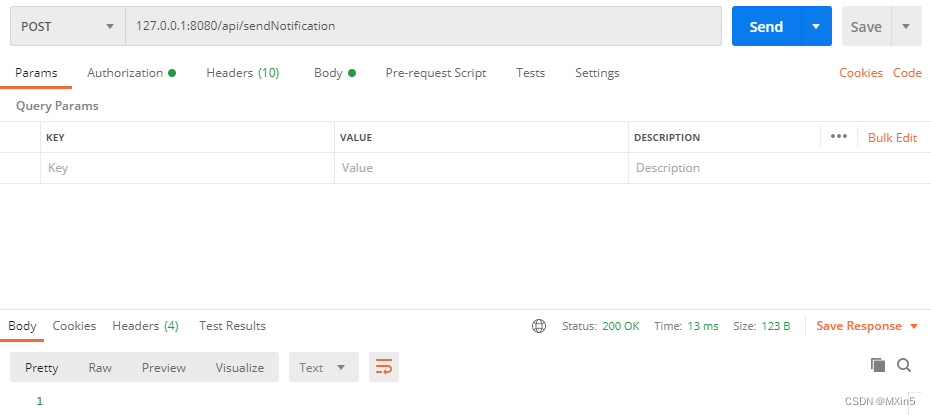- 4、jvm-垃圾收集算法与垃圾收集器
- 基于pear-admin-flask 的 flask 使用教程
- 【项目实战经验】DataKit迁移MySQL到openGauss(下)
- 国产高云FPGA:OV5640图像视频采集系统,提供Gowin工程源码
- Resolved [org.springframework.http.
- 解决org.apache.tomcat.dbcp.dbcp.SQLNe
- MySQL 故障诊断:MySQL 占用 CPU 过高问题定位及优化
- org.springframework.beans.factory.U
- SpringMVC运行时出现404错误(解决办法汇总,基本包含所有错误
- spring boot相关漏洞之零散笔记
- Springboot中LocalDateTime对象返回给前端,格式化
- 分享 GoLand 2024.1 激活的方案,支持JetBrains全
- STM32-SPI通信协议
- 【粉丝福利社】 Node.js从入门到精通(软件开发视频大讲堂)(文末
- MYSQL下载及安装完整教程
- com.mysql.cj.exceptions.CJCommunica
- 【Sql】sql server还原数据库的时候,提示:因为数据库正在使
- 已解决com.rabbitmq.client.ShutdownSign
- freertos 源码分析二 list链表源码
- 【若依】前后端分离部署前端配置二级域名(部署到Nginx上,打开后一直
- SpringAI初体验之HelloWorld
- 【实战Flask API项目指南】之七 用JWT进行用户认证与授权
- 如何学习正则表达式
- Springboot 整合 Quartz(定时任务框架)
- 【vue2】近期bug收集与整理02
- 个人博客系统|基于Springboot的个人博客系统设计与实现(源码+
- 监听Redis中Key值的变化(SpringBoot整合)
- 【Entity Framework】EF配置之代码配置详解
- jenkins+docker集成harbor实现可持续集成
- 2024年04月09日 Go生态洞察:2024年上半年Go开发者调查报
目录
什么是webSocket?
webSocket可以用来做什么?
WebSocket操作类
1.启动SpringBoot项目
2.打开网站
3.进行测试消息推送
4.后端进行查看测试结果
二:测试服务端向客户端推送消息
1.接口代码
2.使用postman进行调用
3.查看测试结果
什么是webSocket?
WebSocket是一种在单个TCP连接上进行全双工通信的协议。WebSocket使得客户端和服务器之间的数据交换变得更加简单,允许服务端主动向客户端推送数据。而Http请求只能从客户端请求服务端才能得到响应。在WebSocket API中,浏览器和服务器只需要完成一次握手,两者之间就直接可以创建持久性的连接,并进行双向数据传输。
webSocket可以用来做什么?
利用双向数据传输的特点可以用来完成很多功能,不需要前端轮询,浪费资源。例如:
聊天功能、数据实时更新和视频弹幕等
webSocket协议
本协议有两部分:握手和数据传输。
握手是基于http协议的。
来自客户端的握手看起来像如下形式:
GET ws://localhost/chat HTTP/1.1
Host: localhost
Upgrade: websocket
Connection: Upgrade
Sec-WebSocket-Key:dGhlIHNhbXBsZSBub25jZQ==
Sec-WebSocket-Protocol: chat,superchat
Sec-WebSocket-Version: 13
来自服务器的握手看起来像如下形式
HTTP/1.1 101 Switching Protocols
Upgrade: websocket
Connection: Upgrade
Sec-WebSocket-Accept:s3pPLMBiTxaQ9kYGzzhZRbK+xOo=
Sec-WebSocket-Protocol: chat
SpringBoot快速整合WebSocket代码案例:
下面我就使用SpringBoot快速整合WebSocket实现服务端与客户端的相互推送消息;
代码层级结构

maven依赖
org.springframework.boot
spring-boot-starter-websocket
WebSocket配置类
package com.example.springboot_websocket_demo01;
import org.springframework.context.annotation.Bean;
import org.springframework.context.annotation.Configuration;
import org.springframework.web.socket.server.standard.ServerEndpointExporter;
@Configuration
public class WebSocketConfig {
/**
* 注入ServerEndpointExporter,
* 这个bean会自动注册使用了@ServerEndpoint注解声明的Websocket endpoint
*/
@Bean
public ServerEndpointExporter serverEndpointExporter() {
return new ServerEndpointExporter();
}
}
WebSocket操作类
通过该类WebSocket可以进行群推送以及单点推送
package com.example.springboot_websocket_demo01;
import jakarta.websocket.*;
import jakarta.websocket.server.PathParam;
import jakarta.websocket.server.ServerEndpoint;
import lombok.extern.slf4j.Slf4j;
import org.springframework.stereotype.Component;
import java.util.concurrent.ConcurrentHashMap;
import java.util.concurrent.CopyOnWriteArraySet;
@Component
@Slf4j
@ServerEndpoint("/websocket/{userId}") // 接口路径 ws://localhost:8087/webSocket/userId;
public class WebSocket {
//与某个客户端的连接会话,需要通过它来给客户端发送数据
private Session session;
/**
* 用户ID
*/
private String userId;
//concurrent包的线程安全Set,用来存放每个客户端对应的MyWebSocket对象。
//虽然@Component默认是单例模式的,但springboot还是会为每个websocket连接初始化一个bean,所以可以用一个静态set保存起来。
// 注:底下WebSocket是当前类名
private static CopyOnWriteArraySet webSockets = new CopyOnWriteArraySet<>();
// 用来存在线连接用户信息
private static ConcurrentHashMap sessionPool = new ConcurrentHashMap();
/**
* 链接成功调用的方法
*/
@OnOpen
public void onOpen(Session session, @PathParam(value = "userId") String userId) {
try {
this.session = session;
this.userId = userId;
webSockets.add(this);
sessionPool.put(userId, session);
log.info("【websocket消息】有新的连接,总数为:" + webSockets.size());
} catch (Exception e) {
}
}
/**
* 链接关闭调用的方法
*/
@OnClose
public void onClose() {
try {
webSockets.remove(this);
sessionPool.remove(this.userId);
log.info("【websocket消息】连接断开,总数为:" + webSockets.size());
} catch (Exception e) {
}
}
/**
* 收到客户端消息后调用的方法
*
* @param message
*/
@OnMessage
public void onMessage(String message) {
log.info("【websocket消息】收到客户端消息:" + message);
}
/**
* 发送错误时的处理
*
* @param session
* @param error
*/
@OnError
public void onError(Session session, Throwable error) {
log.error("用户错误,原因:" + error.getMessage());
error.printStackTrace();
}
// 此为广播消息
public void sendAllMessage(String message) {
log.info("【websocket消息】广播消息:" + message);
for (WebSocket webSocket : webSockets) {
try {
if (webSocket.session.isOpen()) {
webSocket.session.getAsyncRemote().sendText(message);
}
} catch (Exception e) {
e.printStackTrace();
}
}
}
// 此为单点消息
public void sendOneMessage(String userId, String message) {
Session session = sessionPool.get(userId);
if (session != null && session.isOpen()) {
try {
log.info("【websocket消息】 单点消息:" + message);
session.getAsyncRemote().sendText(message);
} catch (Exception e) {
e.printStackTrace();
}
}
}
// 此为单点消息(多人)
public void sendMoreMessage(String[] userIds, String message) {
for (String userId : userIds) {
Session session = sessionPool.get(userId);
if (session != null && session.isOpen()) {
try {
log.info("【websocket消息】 单点消息:" + message);
session.getAsyncRemote().sendText(message);
} catch (Exception e) {
e.printStackTrace();
}
}
}
}
}
注意:WebSocketConfig和WebSocket必须放在同一层级下,否则Websocket扫描不到ServerEndpoint注解。
一:测试客户端向服务端推送消息
1.启动SpringBoot项目

2.打开网站
WebSocket测试 devTest.run
输入
ws://127.0.0.1:8080/websocket/100
进行连接,测试是否连接成功

3.进行测试消息推送

4.后端进行查看测试结果

测试成功,说明客户端可以使用WebSocket对服务端推送消息。
二:测试服务端向客户端推送消息
1.接口代码
package com.example.springboot_websocket_demo01;
import org.springframework.beans.factory.annotation.Autowired;
import org.springframework.web.bind.annotation.PostMapping;
import org.springframework.web.bind.annotation.RequestMapping;
import org.springframework.web.bind.annotation.RestController;
@RestController
@RequestMapping("/api")
public class YourController {
@Autowired
private WebSocket webSocket;
@PostMapping("/sendNotification")
public void sendNotification() {
try {
// 创建业务消息信息
String message = "postman调用接口访问后端服务器存储数据并使用websocket将消息推送给前端客户端";
// 全体发送
webSocket.sendAllMessage(message);
// 单个用户发送 (userId为用户id)
String userId = "1";
String message1 = "【websocket消息】 单点消息:只发送给id为"+userId+"的用户。";
webSocket.sendOneMessage(userId, message1);
// 多个用户发送 (userIds为多个用户id,逗号‘,’分隔)
String[] userIds = {"1", "2"};
String message2 = "【websocket消息】 单点消息:只发送给id为"+userIds.toString()+"的用户。";
webSocket.sendMoreMessage(userIds, message2);
} catch (Exception e) {
// 输出异常信息
e.printStackTrace();
}
}
}
2.使用postman进行调用
用来模仿客户端发送消息到后端服务器然后返回给客户端。(其实也可以直接在WebSocket类中的onMessage中直接进行操作,调用sendAllMessage等其他方法进行测试);

3.查看测试结果
WebSocket测试 devTest.run
正常结果为



还有很多测试方法,自己可以去思考,以上对于SpringBoot整合WebSocket来说可以算是一个简单的入门案例了。














